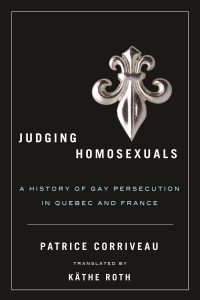In 1997, returning home one evening from a cruise on the St. Lawrence River, criminologist Patrice Corriveau witnessed an assault. Five men were tormenting a sixth.
“A gang of arrogant roughnecks, bursting with testosterone, decided to taunt him; they deem his attire too effeminate and conclude he must be a ‘faggot,’ a ‘queer,’” writes Corriveau. “With unbelievable violence, these brave souls shove the young man around as a crowd watches without reacting or intervening in any way.”
Upset by what he’d seen, Professor Corriveau of the University of Ottawa devoted his doctoral studies to the persecution of gays in French culture, typically men “used as scapegoats by a society disturbed by sexuality,” he writes. The result, La Répression des Homosexuels au Québec et en France, is adapted to English by UBC Press.
Sodomy was punishable by death in Canada until 1869 and decriminalized a century later. Between these two legal milestones Corriveau chronicles the repression of gays not merely for what they did, but for who they were.
Quebec was the first province to outlaw discrimination over sexual orientation in 1977. It followed centuries of arrests of homosexuals as deviant or depraved, culminating in ever-increasing convictions past the Victorian era.
“Homoerotic acts were rarely criminalized in New France,” writes Corriveau; he identifies only five indictments in the 17th century, including a soldier convicted of “unnatural acts” in 1648 and given a suspended death sentence.
earliest Criminal Code in 1892 made sodomy punishable by life imprisonment. The maximum for incest was 14 years. The penalty remained in force until 1954. Yet cases were rare until postwar years. Between 1931 and 1954 the number of sodomy convictions in Quebec grew tenfold, to 212 a year.
What happened? “As long as the image of the homosexual remained that of effeminacy, which was easily identifiable, society had nothing to fear,” writes Corriveau. “With the masculinization of gay culture, homosexuals became difficult to distinguish; in fact, a good number of homosexuals sought to act virile in order to lose themselves in the crowd. Their invisibility made them more frightening.”
Judging Homosexuals has no happy ending. True, restrictive laws were repealed and same-sex unions were legalized. Yet Corriveau remains “haunted,” he writes. In the most liberal province in Canada, decades after discrimination was outlawed, he saw a man beaten before a watchful crowd for the crime of dressing as he pleased.
By Holly Doan
Judging Homosexuals: A History of Gay Persecution in Quebec and France by Patrice Corriveau; UBC Press; 244 pages; ISBN 978-077-4817-219; $29.95








